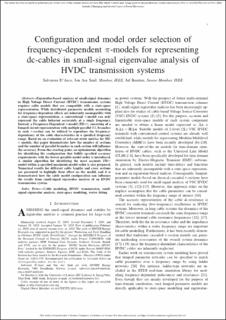Configuration and model order selection of frequency-dependent π-models for representing dc-cables in small-signal eigenvalue analysis of HVDC transmission systems
Peer reviewed, Journal article
Published version
Permanent lenke
https://hdl.handle.net/11250/2673816Utgivelsesdato
2020Metadata
Vis full innførselSamlinger
- Publikasjoner fra CRIStin - SINTEF Energi [1640]
- SINTEF Energi [1764]
Originalversjon
10.1109/JESTPE.2020.2976046Sammendrag
Eigenvalue-based analysis of small-signal dynamics in High Voltage Direct Current (HVDC) transmission systems requires cable models that are compatible with a state-space representation. While distributed parameter models accounting for frequency-dependent effects are inherently incompatible with a state-space representation, a conventional π-model can only represent the cable behavior accurately at a single frequency. Instead, a Frequency-Dependent π-model (FD-π), consisting of a lumped circuit representation with multiple parallel RL-branches in each π-section can be utilized to reproduce the frequency-dependency of the cable characteristics in a specified frequency range. Based on an evaluation of relevant error metrics for FD-π models, this paper demonstrates how the number of sections and the number of parallel branches in each section will influence the accuracy. From this starting point, an optimization algorithm for identifying the configuration that fulfills specified accuracy requirements with the lowest possible model order is introduced. A similar algorithm for identifying the most accurate FD-π model within a specified maximum model order is also proposed. Numerical results for different cable lengths and cross sections are presented to highlight their effect on the model, and it is demonstrated how the cable model configuration can influence the results from small-signal eigenvalue analysis of an HVDC transmission system.

